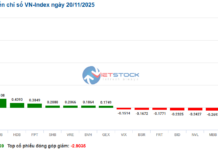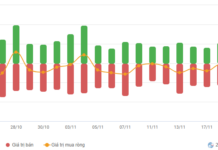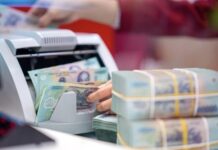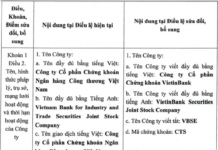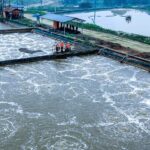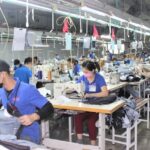At the “Export Promotion Forum 2024” with the theme “Green Export Promotion,” organized by the Ministry of Industry and Trade on December 4, Mr. Nguyen Sinh Nhat Tan, Deputy Minister of Industry and Trade, stated that sustainable development has become a global trend and a strategic orientation for each country’s development.
Among them, sustainable economic development is considered a fundamental pillar and a prerequisite for social progress and environmental protection. Green and sustainable growth is not only an inevitable trend but also a prerequisite for maintaining competitiveness and ensuring the long-term development of economies.
THE BROWN ECONOMY STILL ACCOUNTS FOR 98%
At the forum, Prof. Dr. Nguyen Dinh Tho, Director of the Institute of Strategy, Policy on Natural Resources and Environment, Ministry of Natural Resources and Environment, assessed that to cope with climate change, developed countries, especially the EU, have introduced numerous new regulations, such as the European Green Deal (EGD), Carbon Border Adjustment Mechanism (CBAM), Circular Economy Action Plan (CEAP), and the Biodiversity Strategy for 2030.
To achieve this goal, the EU has institutionalized these regulations into their non-financial reporting requirements. In January 2024, the EU officially required listed companies on stock exchanges to implement sustainability reporting, similar to the ESG reporting currently being implemented in Vietnam. The EU has also introduced due diligence regulations for supply chains.

Thus, the challenges related to Vietnamese businesses in sustainability reporting have become very apparent over time. Specifically, in 2017, the EU imposed an “IUU yellow card” on Vietnam’s seafood industry, which has not been lifted yet.
In October 2023, the EU introduced the Carbon Adjustment Mechanism (CBAM), directly impacting the cement, iron and steel, aluminum, and chemical industries, especially fertilizers, pesticides, electricity, and hydrogen. From January 2025, Europe’s anti-deforestation regulations will directly affect Vietnam’s agricultural products and related industries.
“Thus, the EU and developed countries have turned voluntary regulations related to sustainability reporting, green transition, and digital transformation into mandatory requirements,” emphasized Mr. Tho.
Meanwhile, Vietnam’s current global ranking for its green economy is modest. Specifically, Vietnam ranks 79th out of 160 countries worldwide, placing it in the top 50% globally.
In terms of green infrastructure, Vietnam ranks 94th, in the top 75% globally. Regarding the improvement of the green economy, Vietnam is in the top 25% globally.
The scale of Vietnam’s green economy is at 2%, implying that the brown economy still accounts for 98%. Although Vietnam’s green economic growth has reached 12-13% in the past period, the improvement in its position and green infrastructure remains low compared to the world. This poses a significant challenge to maintaining trade and investment in the coming time.
As of this point, Vietnam’s import and export turnover has reached 800 billion USD, and it could reach 880 billion USD by the end of the year. The target of 1,000 billion USD in import and export turnover is feasible and can be achieved in 2025.
However, Vietnam is still among the top 20 economies with the highest degree of openness globally, but it is also among the top 20 emitters. While Vietnam’s trade scale is only 1%, its emission scale is also 1%.
“Therefore, it is possible that developed countries and Vietnam’s trading partners may sacrifice the Vietnamese market to maintain their position and meet their sustainability goals. Vietnam could be excluded from the market if it fails to fully comply with the regulations,” Mr. Tho worried.
UNLOCKING RESOURCES FOR GREEN GROWTH
Emphasizing the importance of financial resources for green and sustainable development, Mr. Nguyen Ba Hung, Chief Economist at the Asian Development Bank (ADB) in Vietnam, shared that the trend of green finance development worldwide is relatively new. Only since around 2015 has green finance begun to receive attention and experience remarkable growth.
For the Vietnamese market, the trend of green finance growth is relatively positive but still very low. Currently, about 4.5% of the total debt of the banking system is considered green.
On a positive note, according to Mr. Hung, banks have started using green standards and developed their own measures to evaluate environmental and social criteria. According to reports, about 21% of loans now consider environmental and social factors in addition to financial assessments.
However, in general, the representative of ADB assessed that green finance in Vietnam, although growing positively, is still on a small scale.
The number of green bond and sustainability bond issuances in Vietnam has also been modest. “Not every year sees green bond issuances, and the number of issuances is very low, with relatively short terms of only 1-3 years. Therefore, the outstanding balance of sustainability bonds remains almost unchanged,” Mr. Hung assessed.
Hence, to develop green finance, Mr. Hung emphasized the crucial role of businesses. Conditions for green and sustainable finance include production and business activities that meet green and sustainable criteria and social development criteria. These are prerequisites for financial resources to be considered green and sustainable.
“If businesses do not transform themselves into green enterprises, green capital will not flow into those businesses. Enterprises themselves must go green first, and the sources of funding for their green transformation will then become green finance,” Mr. Hung analyzed.
In addition, Mr. Hung suggested that businesses should be ready to implement carbon programs. The government has already planned to pilot this program in 2025 and officially deploy it in 2027.
However, to participate, businesses should prepare to implement a carbon program in the direction that, if they export to the EU according to CBAM regulations, they may need to purchase carbon credits to meet EU requirements. Or, through the evaluation process, we may find opportunities to create additional revenue streams for our business operations.
The Green Port Transition: Sailing Towards Sustainability
Vietnam is lagging behind in the green transition, and there’s a lot of ground to cover. The issue at hand is the need to accelerate this process; otherwise, the country risks missing out on development opportunities and even falling behind as no “green ship” wants to dock at a “non-green port.”
Masan High-Tech Materials: Honored as a “Sustainable Enterprise” for Seven Consecutive Years
On November 29, Masan High-Tech Materials, a leading provider of advanced materials, was once again recognized for its sustainability efforts, securing a place in the prestigious Top 100 Sustainable Businesses in Vietnam (CSI 100). This acknowledgment underscores the company’s unwavering commitment to environmental stewardship, social responsibility, and strong governance practices.
“The Green Finance Challenge: Transforming Vietnam’s Commercial Credit Landscape”
Green finance in Vietnam accounts for a mere 4-5% of commercial credit. Notably, over 80% of this green finance is directed towards sectors such as electricity, utilities, agriculture, and green buildings.

